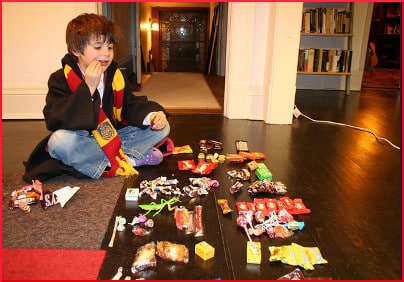
First, before children set out on their trick-or-treat rounds, or before they go to a party, or before you host your own party, do your best to fill them up with a good meal. Sure, kids are capable of eating an enormous amount of attractive junk, but when a plateful of legitimate nutrients has already gone down the hatch, it actually could make a difference. Sometimes, “Can’t hurt, might help” is the best a parent can hope for.
When it comes to the trick-or-treat harvest, Childhood Obesity News has already recommended advance negotiation. The time to work this out is now, before things get really exciting and while the pile of brightly wrapped sugar bombs is still theoretical. Once the junk-food avalanche shows up as a reality, it’s hard to cut a deal.
Agency
Even if their power is only illusory, kids like to have some agency — some say in what goes on. They can also surprise adults with their empathy and willingness to share. One thing is certain — imposing a top-down rule is usually counterproductive. The more input a child has, the more likely a good result becomes. Start by clarifying the goal, which is to have some kind of ration scheme in place so the sweets will not all be eaten at once. Elicit a child’s cooperation in making a plan, and you’re halfway to success.
Or start by establishing that most of the candy will be given away, and let the child decide whether “most” will be determined by weight or by item count. Operation Shoebox and Halloween Candy Buyback are programs that send donated goodies to the troops. Or maybe there is a homeless shelter in your area. Present two choices, and let the children decide whether the beneficiaries of their generosity will be soldiers or homeless kids.
A child may ask, “If this stuff is so bad for me, why is it okay for them?” Just say, “Glad you asked. You’re absolutely right. It’s not really good for anybody, but soldiers are very active, so they burn up the calories. Homeless kids don’t get many treats. This way, you have some candy instead of a lot, and they have some candy instead of nothing at all.” And be glad you have a kid with a sharp enough brain to think about those kinds of questions.
Kate Harrison suggests a course that many parents may see as a last resort, while others sigh with relief at its availability. For Forbes, she writes:
Another option I have seen work well, especially with slightly older kids, is cold hard cash. A one-time buyback can get you most of the way there. A follow up a few weeks later, when the allure of candy has dwindled a little bit and the best candy is gone (a.k.a. when demand is down), can finish off the pile.
Harrison’s assumption that any of the sugary swag will still be around “a few weeks later” may be overly optimistic, but the basic idea could keep harmful substances out of a child’s digestive system, which is always a plus.
Post trick-or-treat
So, that’s part of the program for Halloween night — kids can sort out what they have collected, separate it into categories, and wrap up the portion to be given away. Here is a major tip, especially if the kids are wearing original creations. On the afternoon or night of your Halloween party, or after trick-or-treat, devote some time to a substantial photo session documenting the brilliant, innovative costumes. Or with some preparation, you can play an elaborate, spooky game like the one used by horror writer Ray Bradbury for one of his most memorable stories. On the 31st, take on the mission of providing enough entertaining activities that kids have something to do besides eat candy.
Next: one possible scenario of how a minimal-sugar Halloween night could play out.
Your responses and feedback are welcome!
Source: “Can You Buy Back Childhood Obesity?” Forbes.com, 11/03/2013
Image by Nina Hale

 FAQs and Media Requests:
FAQs and Media Requests: 











